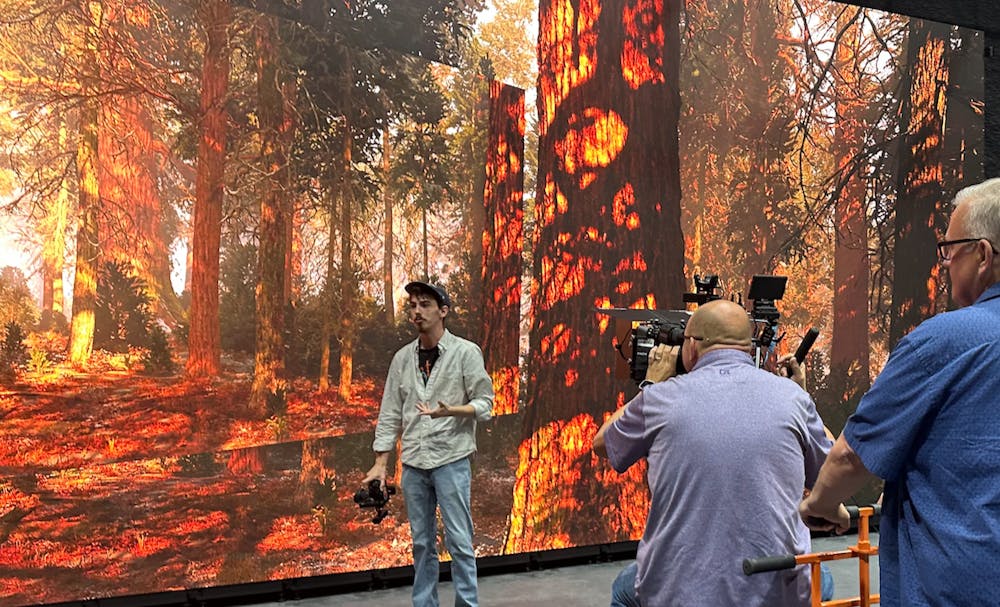A brand-new dimension was added to the view inside of the Horne Academic Center at Taylor University when it installed one more wall in the building.
Down the hall in the building is a gigantic sound stage. The dark room built to house film productions will now hold an opportunity for students to capture the virtual world on film.
The optimized LED wall is designed to produce a background that appears to be three-dimensional (3D) to a camera, John Bruner, professor of film and media arts, said. As the camera eye moves across the set, viewers will be able to see deeper into the visuals on the screen.
Supplies for the wall arrived on Taylor University’s campus Aug. 26, during the first week of classes. A team from Vu Studios came to install and program it during that time.
The structure was composed of panels made up of smaller modules, Joshua Taylor, media engineer and adjunct professor of post-production, said.
On Aug. 29 and Aug. 30, Envision student workers were trained by three staff members from Vu, a virtual production studio network.
The students learned how to buy a previously made environment, load it onto the LED wall and manipulate the graphics, Elise Masters, a senior film and media arts major and student secretary for Bruner, said.
This was the first time Masters had ever gained hands-on experience with this new type of 3D technology. While some of the terminology was hard to understand, Masters said she was impressed with how realistic the visuals were.
“It seems like it would take years of learning to use it,” she said. “But at least for the very most basic features, it's actually super intuitive to learn.”
On the first day, students scanned a QR code to be able to select backgrounds for the wall, Masters said. They participated in setting up a miniature film set and cameras to learn how to arrange lighting.
The Vu team spent the second day walking students through the process of using Unreal Engine with camera trackers.
The 3D computer graphics tool is used for video game development, Taylor said. He added that the film industry adapted the Unreal Engine gaming software to use it for virtual production so that the LED wall could function at its best.
Taylor said that he and Bruner started researching computer-generated imaging (CGI) several years ago, looking for a product that would fit the film department’s needs and budget.
LED volumes have paired well with virtual production because 3D images can now emit light onto a scene, he said. This ends up helping actors interact with their surroundings more, making their performances more believable.
Bruner said that a large part of the process is making sure that the set is well-lit and tracking is working properly on the camera.
The area of the wall inside of a film camera’s view will get processed and capture a 3D visual, he said. However, viewers standing in the sound stage will at a certain point see the images on the two-dimensional screen stretch and get distorted.
“Looking at it, it looks like a disaster,” he said. “But on the camera side, it looks correct.”
It will be an ongoing learning process to incorporate this technology into classes and filming, Bruner said. He will plan on introducing it into Directing and Cinematography, an upper-level class that focuses on creating different approaches to film.
Masters, one of the students in the class, said she has a lab every Friday where she will be learning how to implement the 3D technology into her film projects.
She added that she could see herself incorporating a hospital scene into a larger project, with the LED wall functioning as a window cut-out, situated behind the set.
For JP Susantio, a senior film and media arts major and Envision staff member, the sky is the limit.
“Because this is senior year, I just feel really lucky that we (will) be able to use it, where it's also kind of scary and daunting, because we are kind of the guinea pig class to use this,” he said.
Susantio is excited for future classes to get to use the technology, adding that he can see how current students will be setting the bar for the quality that the department can get out of the technology in years to come.
Bruner said that the department will have to work out conflicting schedules for students and classes using the sound stage, as it will be utilized for set production and filming crews.
He added that a lot of hard work was put into obtaining the expensive equipment the film department now has, but he credited his students with taking good care of it, describing them as “ready.”
“I think it's kind of funny that people are afraid of AI,” he said. “I think AI is afraid of our students.”





